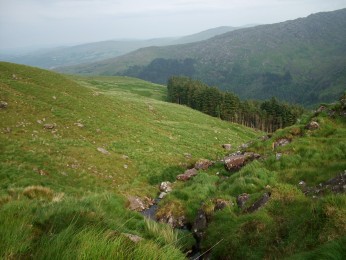
Kieran’s Our City, Our Town Article
Cork Independent, 8 December 2011
In the Footsteps of St. Finbarre (Part 278)
Creating Ireland’s First National Park
In 1960, the national element of Gougane Barra was once again invested in when it was chosen as Ireland’s first national park. In the late 1950s, plans were drawn up to open up some of Ireland’s particularly attractive forest blocks as national forest parks. Up to that point in time, investment in state forests amounted to £22.5 million. The investment aimed to achieve maximum utilisation of the land, that patches of land, which could not be used economically for pasture or tillage, could be be devoted to timber production The forestry division in 1963 provided direct employment for 4,500 men, 330 of whom were employed in Cork and Kerry forests. In 1963, the State planting rate was 25,000 acres per annum.
Apart from the economic advantages, the state also sought to improve local scenery affected by forestry plantations. In this light, it was decided to develop a number of national parks, providing new recreational facilities and contributing to the development of the tourist industry. Gougane Barra in Co. Cork and the Derrybawn and Lugduff properties of Glendalough were selected as the first two areas of development, or the Republic’s first forest parks. A grant was secured in September 1960 to create a new road into the heart of Gougane’s forestry scheme. The layout of the park officially began in late December 1961.
A journalist with the Irish Independent on 1 January 1963, (p.20) noted of Gougane Barra’s forestry:
“Up to recently, on the mainland, it was possible to drive only a short distance past the island. There the road ended. A narrow path continued for some distance towards the boundary of the forest nearly a mile away. It was here deep in the valley, that the forestry division of the Department of Lands began planting about 24 years ago. Today, the trees, including magnificent spruce, larch and silver fir, are tall and stately. It is here that the national park is taking shape.”
The idea of opening the forest to the public first was put forward by Colonel Roland H. Packwood who was engaged as a consultant to the Irish Forestry Division in 1937. He formed the idea from his experience with the British Forestry Commission, in which he served as Chief Engineer. As such he was responsible for the 400 forests in Britain, and when he retired he was invited to prepare a report on the afforestation needs of Ireland. For three years leading up to 1961, he visited Ireland and on one occasion suggested the idea of a national park to the Minister for Lands Mayo Fianna Fáil TD Micheál Ó Móráin. Colonel Packwood had also visited forestry areas in India, New Zealand and Australia. Full support was given by the Minister. In 1957 Micheál Ó Móráin was made Minister for the Gaeltacht. He was a native Irish speaker. He was appointed Minister for Lands by Taoiseach Seán Lemass, in 1959 and was re-appointed to the Gaeltacht portfolio in 1961. He remained in these two Departments until 1968.
Work in Gougane Barra began under the supervision of engineer Mr K McGarry, Mr Con Lynch, Divisional Engineer, Cork and Mr D. O’Driscoll, forester, Ballingeary. Construction of an 18 foot wide link road from Gougane Barra to the forest began early in 1961. Inside the forest, a circular loop road, over 2 ½ miles long was made. This was the difficult part of the project. The road in many places had to be cut out of rock using dynamite. By the time the road was completed, more than 10, 000 tons of rock and soil had been moved. All this had to be accomplished without major damage to valuable trees. At one point the road passes over two small streams, one of which comes down from Nead An Iolair, the source of the Lee.
A visit by the Irish Independent journalist in early 1962 noted of the area’s history:
“In a recent visit we left the unfinished road and climbed further up the mountain to a spot where one can straddle the famous river, one foot on each bank. This place has a niche on history too. The road at another point passes at the base of a deep ravine. It had been seen by few people because of it’s previous inaccessibilty. Known locally as Poll, or the Black Glen, it was used once by the West Cork Flying Column in their famous trek to avoid encirclement by British forces during the War of Independence. The column led by famed Tom Barry, was being confined in the valley of Coomhola on the Kerry side of the mountains. A British pincer movement was an all-out drive to smash the fighting men of West Cork. All escape routes were cut off. A local guide led the column in a night escape across treacherous, boggy land.”
Gougane Barra Forest Park was officially opened on 20 September 1966. The Irish Press reported of Micheál Ó Móráin, Minister for Lands, opening the forest park and sharing the news that new national forest parks were proposed for Glendalough, Co. Wicklow and at Lough Key, Co. Roscommon (see www.coilte.ie for more on these).
To be continued…
Caption:
620a. The ‘baby’ River Lee in Gougane Barra Forest Park (picture: Kieran McCarthy)